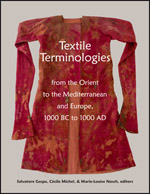Center, Textile Research

Textile Terminologies from the Orient to the Mediterranean and Europe, 1000 BC to 1000 AD
Date of this Version
2017
Document Type
Article
Citation
In Textile Terminologies from the Orient to the Mediterranean and Europe, 1000 BC to 1000 AD, ed. Salvatore Gaspa, Cécile Michel, & Marie-Louise Nosch (Lincoln, NE: Zea Books, 2017), pp. 24-46.
doi:10.13014/K2CJ8BNP
Abstract
Among the operations required in the overall cycle of the ancient production of textiles, Greek and Roman sources refer to the fulling of woollen fabrics as the most complex and expensive technical process performed both in the 1st millennium BC and the 1st millennium AD. Indeed, the finishing of woollen clothes needed a large amount of time, energy and labour, as well as involving the use of specialized skills and costly raw materials. Fulling fulfilled two functions that were necessary for the proper finishing of cloth, namely the scouring and consolidation of the fibres in the fabric. Woven cloth straight from the loom has a rather open, loose texture and the woven threads needed closing or tightening. The fulling process was intended to consolidate and thicken the structure of the fabric by matting the fibres together more thoroughly and by shrinking them. Thus the process transformed the cloth from a loose ‘net’ of threads into a compact, tight, textural whole. This is why in ancient economies, fulled textiles, proof against water and the wear inflicted by weather and time, were considered among the most luxurious and prestigious of fabrics.
Textual, iconographical and archaeological evidence from the Greek and, especially, Roman civilizations provide together quite a complete picture of the procedures, the tools and the raw materials involved, with special emphasis on their natural and geographical origins.1 In contrast, for pre-Classical fulling, archaeological and epigraphical evidence on the technical phases in the finishing of textiles are unfortunately very scanty, deficient and often of doubtful interpretation. This situation applies to Mesopotamia too. Here the earliest cuneiform texts related to the finishing of woollen textiles date back to the end of the 3rd millennium BC, while seals and sealings representing scenes of fullers at work attest the presence of this technology even around the middle of the 4th millennium BC according to some historians. 2 In fact the terminology of the cuneiform texts limits itself to the name of the textile workers involved, the woollen fabrics undergoing the different operations, and a few raw materials, but they do not describe how technical operations were carried out and the sources of the materials the fullers utilized. Therefore, the study of natural resources mentioned in 1st millennium Classical texts is extremely useful: it helps first to close the loopholes in both earlier and contemporary cuneiform documentation, and then to better understand the economic and cultural role played by specific plants, animals and minerals belonging to the Near Eastern ecosystems before the advent of mechanized fulling. Several scholars have stressed the substantial uniformity of the technology of fulling, whose procedures and raw materials remained unchanged from Classical antiquity until the end of the Early Middle Ages, when the fulling of cloth was carried out in a textile water mill.3 It is hence believable that even before the 1st millennium BC Near Eastern fullers were exploiting the same or analogous natural resources for cloth-making, using them in the finishing of woollen fabrics in the same technical operations.
Therefore, this present research employs 1st millennium BC and AD sources to draw an ethnographic parallel with the fulling operations, tools and raw materials recorded in Near Eastern textual documentation during the two previous millennia. Sumerian and Akkadian terminology linked to technical procedures, but also to the names of plants, animals and minerals occurring in the cuneiform texts concerning the finishing of woollen textiles, will be analysed in the light of the historical and anthropological comparisons with the Greco-Roman world. This should reveal new or overlooked aspects of the Mesopotamian and Near Eastern fulling as performed in the Bronze and Iron Ages.
Included in
Ancient History, Greek and Roman through Late Antiquity Commons, Art and Materials Conservation Commons, Classical Archaeology and Art History Commons, Classical Literature and Philology Commons, Fiber, Textile, and Weaving Arts Commons, Indo-European Linguistics and Philology Commons, Jewish Studies Commons, Museum Studies Commons, Near Eastern Languages and Societies Commons, Other History of Art, Architecture, and Archaeology Commons


Comments
Copyright © 2017 Salvatore Gaspa, Cécile Michel, & Marie-Louise Nosch. Photographs copyright as noted.